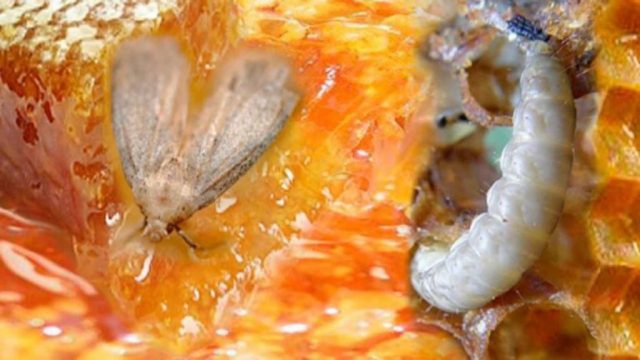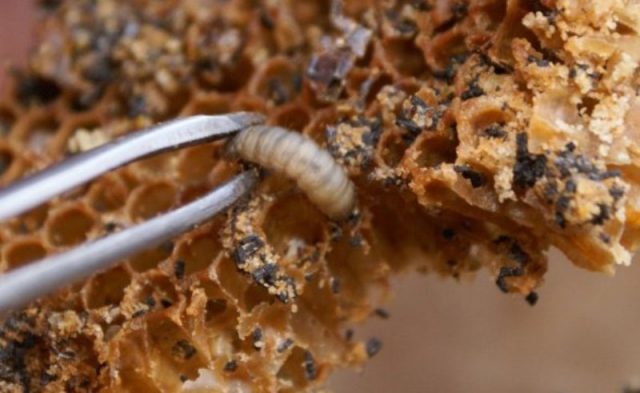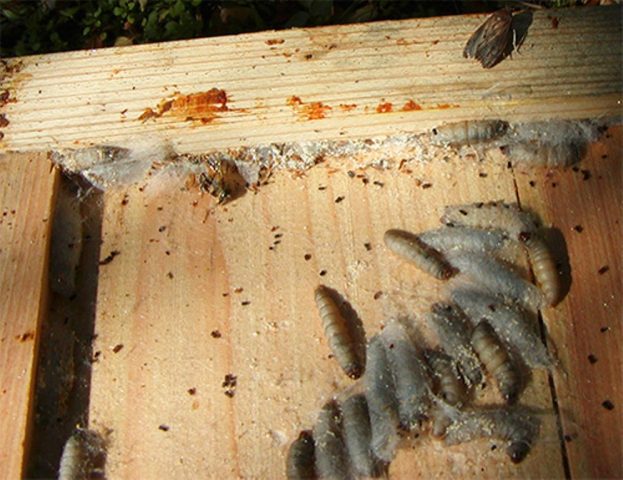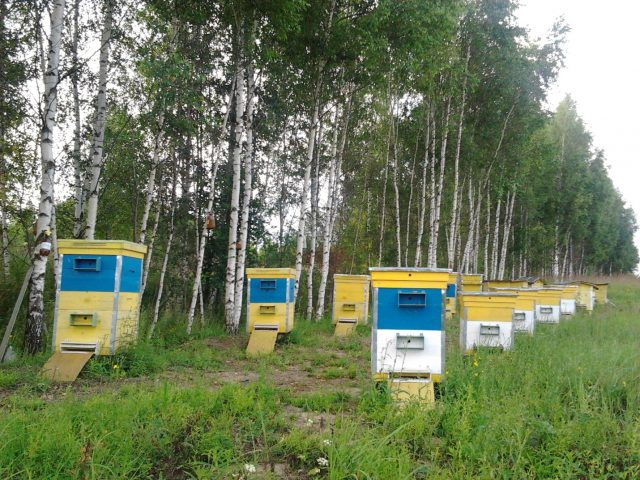Content
Keeping bees is not only a hobby and getting tasty nectar, but also hard work, as hives are often infected with various diseases. The wax moth is a common pest that causes great damage to the apiary. The moth itself is harmless, the larvae pose the greatest threat. They eat combs, honey, bee bread, propolis and spoil bee cocoons. When a wax moth appears in the hive, the swarm immediately leaves its dwelling.
What is "wax moth"
The wax moth is a mole-like, nocturnal butterfly from the Ognevok family, with which beekeepers fight annually.
The life cycle of an insect consists of 4 stages:
- egg;
- caterpillar;
- chrysalis;
- an adult.
The attitude towards this insect is different. Some are fighting with her, others are bred on purpose. This is explained by the fact that the larvae, eating the beekeeping product, absorb all the useful substances. As a result, the insect becomes useful and can save from many ailments. But in order to make a natural medicine, an entire hive must be sacrificed. Only industrial farms can grow caterpillars, mainly beekeepers are fighting a merciless fight against this insect.
What does a wax moth look like?
There are 2 types in nature:
- Large wax moth - a large insect, with a wingspan of 3.5 cm. The front pair of wings is colored dark yellow, the hind ones are beige.
- Small wax moth - The wingspan is 2.5 cm, the front wings are gray-brown, the rear ones are off-white.
In an adult, the mouth organs are not developed, so it does no harm. Her role is procreation. The larvae, on the contrary, eat everything in their path, even their own excrement, eating up for life.
Wax moth larvae
The caterpillar develops for 4 days. After hatching, it reaches a length of 1 mm, has 16 legs and a pair of bristles on the back. After birth, she is inactive, feeds on honey and pollen. Then it begins to actively move and eat everything in its path.
A light white caterpillar with a dark head makes its way along the edges of the combs and in the walls of open cells. Over the entire life cycle, an adult larva eats up to 1.3 g of wax. On the one hand, this is not so much, but 3 generations of 5 pairs of moths can destroy up to 500 kg of land per season.
If the pest has settled in the bee house, then bee will stop laying eggs, and bees will stop bringing honey. When an insect appears, the bees begin to fight it, but in just a few hours the parasites become very numerous and the shaggy workers miss some clutches. If you do not start a timely fight, the bee colony will leave the hive.
At what temperature does the wax moth die?
Since the wax moth is a moth, it is afraid of sunlight. This photophobia can be used as an insect control. To do this, the sushi affected by the larvae are exposed to the sun and after 2-3 minutes the larvae leave their home. If the honeycomb is left at a temperature of 10 ° C, then a large wax moth at all stages of the life cycle will die in an hour and a half.
A small moth does less harm to honeycombs, develops at a temperature of 30 ° C. At temperatures below 16 ° C and above 35 ° C, eggs die.
Why a pest is dangerous for bees
The moth is one of the main pests of the beekeeper, causing great damage to the economy. It affects weak colonies, malformed cuttings and polypore colonies. At night, the parasite lays eggs, from which gluttonous larvae appear, which feed on honey, bee bread, warming hives and honeycombs. They also harm the brood. When the parasite colonizes, bee colonies begin to get sick, they may die or leave their home.
Methods for dealing with wax moth
Before getting rid of wax moths in hives with bees, you need to know the causes and signs of parasite infestation.
The signs include:
- decreased productivity;
- bees are lethargic, rarely fly out for nectar;
- cream worms appear at the bottom;
- in the compartments, you can find moth feces, resembling onion seeds;
- at the bottom of the hive there is a large number of dead bees; when viewed from insects, the wings and legs are shrouded in a thin web;
- if you bring a burning match to the taphole, and then gently shake the bee dwelling, you can see small larvae at the bottom of the hive.
The following factors can provoke the appearance of parasites:
- non-compliance with cleanliness in the hives;
- weak bee colony;
- high humidity;
- the family was left without a womb;
- high temperature in the winter house;
- untimely removal of dead bees in the compartments.
The bee house needs timely cleaning. Often, when harvesting, larvae, excrement of wax moths are found in bee bread, in this case it is necessary to free the hive, thoroughly clean it and disinfect it.
If an accumulation of cobwebs has formed between the combs, it means that the insect has made a nest for itself, where it lays its eggs. When honeycombs are found, they are removed from the hive, the site of infection is well treated. In place of the old honeycomb, new ones are installed. Do not use combs from other bee houses, as they can also be infected with the parasite.
There are several ways to deal with wax moths in hives:
- chemical;
- physical;
- folk remedies.
Wax moth preparations
Many beekeepers use a chemical method to combat wax moths. The medicine can be purchased at any pharmacy.
- Formic acid - use 14 ml of the preparation for each case. After 1.5 weeks, the procedure is repeated. The honeycomb is ready for use after 7 days of airing.
- Sulfuric gas - for 1 sq. m premises burn up to 50 g of sulfur. Processing is carried out indoors. The treatment is repeated several times, every 14 days. The drug is harmful to humans, therefore, insect control is carried out in a respirator. Before using the hive, ventilate it thoroughly. Sulfur can be harmful to health, no matter how the bees clean the cells, the particles of the chemical element still remain. And a persistent smell hovers in the hive for a long time. When collecting honey, there is a possibility of sulfur getting into the bee product.
- Vinegar - 1 hive requires 200 ml of 80% of the drug. The fight is carried out for 5 days in a row. The honeycomb is ready for use 24 hours after airing. Vinegar will not only get rid of insects, but also disinfect the hive.
- Askomolin - take 10 tablets per 1 frame, wrap it in material and place it inside the house, do not remove the honeycomb from the hive. The hive is wrapped in polyethylene and left for a day. Frames are ready for use 24 hours after airing.
- Paradichlorobenzene (antimole) - the medicine is placed between the frames at the rate of 150 g per cubic meter. Processing is carried out for 7 days, after which the hive is aired for a week.
- Biosefe - for the fight, the drug is used in the form of a freshly prepared aqueous suspension. Spraying of honey-pergovaya sushi is carried out at the rate of 30 ml for each street. The effect occurs in a day, the drug acts throughout the year.
- Entobacterin - honeycombs are sprayed with 3% preparation at the rate of 25 ml per 1 frame at a temperature of 30 ° C.The moth begins to eat the wax soaked in the solution and dies. The drug does not harm bees and brood.
- Thymol - an effective drug for fighting the night butterfly. The powder is poured into a gauze bag and placed on top of the frame. The treatment is carried out 2 times, but at a temperature of 26 ° C, the preparation is removed from the hive.
What to do if a moth is in a hive with bees
If white worms appear near the hive - this is the first sign of the presence of a wax moth in the hive, the bees begin to fight it on their own. Such a home needs to be monitored and treated. For this, sweet traps are placed nearby - they attract the parasite, moths drown in them, not having time to fly to the bee dwelling.
If the hive is heavily infected, then the bee colony is moved to another dwelling, adding a small amount of food to the new combs. After moving the bees, the bottom is cleaned of caterpillars, cobwebs, other debris and poured over with fire. To do this, use a bundle of straw or a blowtorch. The corners, slots, bottom and tray are treated with fire.
How to deal with wax moths in a honeycomb storage
Cell storage is a storage room for spare cells. They should be located at every responsible beekeeper. They are sometimes kept in a cellar, basement, or unheated garage. To prevent the appearance of parasites, regular disinfection and prophylaxis against wax moths are carried out.
In honeycomb storage, wax moth appears at high temperature and humidity, as well as poor ventilation.
Stopmol is a common medicine for combating wax moths in honeycomb storage. The preparation consists of small cardboard plates impregnated with fir and coriander oil. The medicine has an insecticidal effect and affects the moth at different stages of development.
Instructions for dealing with wax moths with Stopmol for bees:
- The affected combs are removed from the hive.
- Open the package and make 4 1 cm holes in the corners on each plate.
- The drug is laid out on honeycomb frames and packed in polyethylene or put into sealed honeycomb storage.
- To completely get rid of insects, you must use 1 plate for 12 frames.
- The course of treatment is 1.5 months, after which the plate is removed, and the frames are ventilated.
How to get rid of wax moths on frames
If a massive infestation has occurred, it is necessary to immediately begin the fight against the pest. Beekeepers use a mechanical, chemical method or cope with folk remedies.
How to keep dry from wax moth
Particular attention is paid to the storage of sushi in late summer, early autumn. In winter, due to the lowered temperature indicators, the likelihood of the appearance of parasites is minimal. Therefore, in spring and early summer, the wax moth does not bring big problems to the beekeeping farm. In the summer, the parasite begins to actively multiply, if you do not carry out prophylaxis, then the consequences can be dire.
Beginning in July, the framework must be carefully checked. Drylands where the pest has just started can be rearranged into a strong family or, after isolation, treated against the parasite in one of the proven ways.
To prevent massive infestation, you need to know that the wax moth primarily infects frames with brood, as well as with a large amount of bee bread. Therefore, store frames, where brood never occurs, are stored separately. Sushi is stored in empty hives, laying oilcloth or polyethylene between the hulls.
Special attention is paid to the frames from under the brood and bee bread: they are regularly examined and, if necessary, they begin a timely fight against parasites.
How to deal with wax moth folk remedies
Experienced beekeepers do not use chemicals to get rid of wax moths, but fight it with folk remedies. Proven Ways to Deal with Wax Moth:
- Tobacco - a strong natural medicine to combat wax moths. During flowering, the tobacco is cut at the root and transferred between the combs. There is enough foliage from one bush to process 3 bodies.
- Marigold - flowers are laid out in a honeycomb storage. Their aroma prevents wax moth infestation.
- Fumigation with smoke Is an old proven way to get rid of wax moths. To do this, the land is fumigated with smoke from a smoker. In a container lined with tin, frames are placed in several tiers. Through the lower entrance, the space is filled with smoke. Combustion is maintained for 24 hours. This procedure is carried out in spring and late autumn, 3 times with an interval of 7 days. If the combs are infected, the caterpillars will begin to die on the second day of the fight. After the procedure, the frames are ventilated, and the shaggy workers willingly use the processed honeycomb.
- Sagebrush - frames in the honeycomb storage are covered with fresh wormwood on all sides. The smell of grass repels parasites.
- Aromatic herbs - freshly harvested mint, wormwood, oregano, hops and walnut leaves are cut and laid on the bottom of the bee dwelling. The frames are installed, another layer of cut grass is placed on top. The freshly picked aromatic herb is indispensable in the fight against wax moths.
- Mint infusion - 30 g of herbs are diluted in 50 g of boiling water and insisted overnight. The solution is processed by the streets between the frames. The infusion is harmless for bees. After processing, they work in the same mode, and the butterfly larvae fall off. After a week, the procedure is repeated.
- Garlic - in the fall, before harvesting honeycombs in the honeycomb storage, they are cleaned of propolis and rubbed with garlic. The hulls and empty hive are also treated with garlic. In the spring prophylaxis is repeated. After processing, the wax moth does not appear in the apiary, the bees are healthy and highly productive.
- Salt - a popular way to fight the night butterfly. For processing, the frames are cleaned, sprayed with brine and stored. In the spring, the frames are washed with water and placed in the hives. After the saline solution, the parasites do not settle in the bee houses.
A set of preventive measures
In order not to face a problem, it is necessary to carry out preventive measures:
- keep the apiary and hives clean;
- at the first signs, it is timely to start the fight against the wax moth in the hive;
- fix problems in time: repair frames, close up cracks and cracks;
- keep the wax in a closed container and, if possible, immediately process it;
- Store the backup cells in a dry, cool, ventilated area.
Also, experienced beekeepers plant plants next to bee dwellings that repel insects. These include:
- mint;
- Melissa;
- marigold;
- sagebrush.
To prevent moths from entering the hive, traps are set around the perimeter. A mixture of honey, bee bread and yeast is poured into bowls. The moth is also attracted to the smell of vinegar. It is bred in water and also placed next to the dwelling. To prevent the larvae from crawling into a clean hive, a small moat with water is made around the hive.
Frames should be regularly inspected for the presence of the parasite. Upon detection, they immediately begin to fight to save the bee colony.
Wax - attracts wax moth, so you cannot keep supplies where shaggy workers live. To save the hive from the passage of larvae from one building with land to another, polyethylene, oilcloth or newspaper are spread on the lid (the moth repels the smell of printing ink).
Conclusion
The wax moth is a dangerous enemy for the apiary. But if you keep the hives clean and take timely preventive measures, the insect will not harm the bees and will not create problems for the beekeeper.












